21st February 2008 : Cheetah for Breakfast
 Thursday, February 21, 2008 at 11:36PM
Thursday, February 21, 2008 at 11:36PM 8.15am it was, and we were sitting on the balcony having breakfast when – blow me down with a feather – a Cheetah walked out onto the beach near our well, down to the left of the house! It spent a long while meandering over the sand, and then had a good long drink (which is unusual for cheetahs who hardly ever have to drink. They get all the moisture they need from feeding in a specialized way – rolling the skin back off their prey so that all the moisture from the carcass collects at the bottom). The cheetah was just making its way back towards the tree-line when a hapless dik dik appeared out of the undergrowth and not seeing the cheetah, wandered out onto the sand. Needless the say, the cheetah made short work of that (adding a new meaning to ‘fast food’). It seemed rather an unequal contest, for the poor dik dik would have required nothing short of divine intervention to get away from the fastest land mammal on the planet on a wide open stretch of beach. Within a few short seconds, we were not the only ones having breakfast…
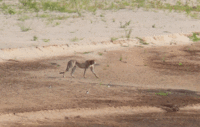
Cheetah on the beach
click any image to enlarge
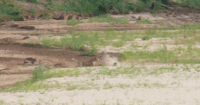
Cheetah chases dik dik...
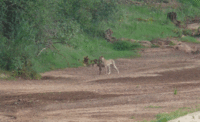
Cheetah carries away dead dik dik into thick bush near our well
The action took place too far away to get any decent photos, but I’m afraid I’m subjecting you to them nonetheless, if only for my own memories of this action-packed morning. We went down onto the beach later and I photographed the cheetah’s pug marks in the sand. Cheetahs are like dogs, in that they cannot retract their claws. It’s very difficult to tell cheetah and hyena paw prints marks apart, but at least on this occasion, I can categorically state these belong to a cheetah. In one photo, I have tried to illustrate the incredible reach of one bound when the cheetah was at full stretch and full throttle in pursuit of the dik dik – one stride must be over one and a half meters long.
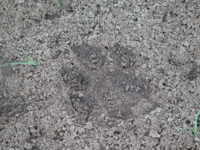
Cheetah pug mark
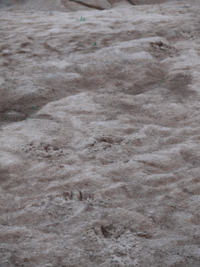
If you look at the back of this image, you can see how far the cheetah can extend its stride when it runs at full stretch (as evidenced by the length between the pug marks)
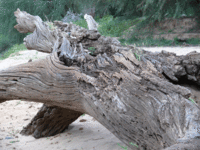
The perfect massage aide for an elephant...
It is full moon, and the night is alive with the sounds of elephants: deep rumbles, splashing in the river and tearing and munching of reeds. We can see their gentle silhouettes feeding in the reed islands in the river opposite the house. There have been a lot of elephants around in the past few days, with several herds crossing the river in the late afternoons. The old fallen down log on our beach (above, right) is also mud-stained from the elephants having a good butt-scratch as they pass by.

Other animal visitors over the past few weeks there have been aplenty too, even though I have been too busy to record them here. So here’s a quick “Creature Catch-up” (I apologise in advance for reeling off a list in a somewhat listless manner, but it’s midnight and I am exhausted!):
We had a pack of hyena on the opposite bank one night – about five of them. Normally when they get together like this, it means they’re hunting – probably buffalo in this case, considering the game which is around at the moment. The other night we watched a single old buffalo crossing the river, a silhouette splashing its way across the water. This lone buffalo is the kind you don’t want to meet when out walking…
The other day we had three baboon troops within our field of vision – one to the left of the house, one to the right, and one across the river…as often happens, the impala were there too, taking advantage of the safety provided by the baboons’ sharp eyesight. The three young male Impala seem to have practically taken up residence on the ‘Little Serengeti’, alongside at least three or four pairs of dik dik – though they may now all be keeping a very low profile with the cheetah around. The vervet monkeys continue to pass by the house on a daily basis, stopping to raid the bird table if none of us are in sight. Crocodiles abound, as usual; there are lots of smaller ones at the moment, with the occasional big guy drifting past on the current.
We had a fabulous show from the hippos the other evening – there were a few youngsters having a boisterous game, and providing great photo opportunities.
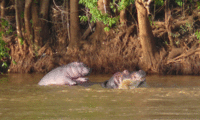
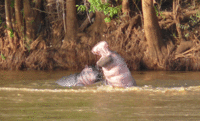
Our resident genet cat, whom we call Jean-Genie (and whom we now suspect may actually be three or more genet cats!) is still coming regularly for the goodies I leave out for it/them on the bird table. Tonight, the genet was racing back and forth through our lounge, taking a short cut to the bird table and the chicken left-overs, while we sat watching it from outside on the balcony.
Finally, I had fun comparing lizards one morning earlier this week. Within the space of a couple of minutes, I saw the adult male agama lizard, in all his blue and orange splendour (about 20 cm long, including tail), several baby agamas – greeny brown and only about 6cm long, and finally a giant water monitor lizard, at lease one metre long…it really brought home to me the wondrous variety of the life around us…

SMALL (baby agama lizard)...
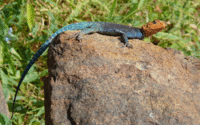
MEDIUM (adult male agama lizard)...

LARGE (water monitor)








Reader Comments (12)
Oh my golly gosh, a cheetah. How exciting! That was the one creature we didn't get to see in South Africa. You have such a wonderful view on life, in the real sense, just by looking out on your property. I envy you.
Those Dik Diks aren't the biggest of species I see. The cheetah had one good morning, I think he'll reside near your pool a while longer. Elephants, hippos, lizards, it's like living in the zoo :D
A cheetah! Amazing, lucky you again! Thanks for letting us share your adventures.
When I was tracking "my" cougar in Canada (one I learnt much about but never saw) I learned from a tracking website that cat pugmarks typically have an M-shaped heel pad, with a little dip on the top side and three prongs on the lower side. Dogs have more of an inverted V shape, with two prongs on the lower side. Obviously, I know hyenas aren't dogs, and I've never tracked one so I'm not sure what sure their heel pads are!
I saw a genet of unknown species (feline?) on Mount Kenya but it must be wonderful to have them hanging around your house like that! Beautiful creatures.
Thanks for all the comments! You're right, Manictastic, dik diks are very small antelope...but there are LOTS of them in this area. That's probably one of the reasons why the cheetah (conventionally an open country predator) is able to survive in the thick bushland areas of Tsavo...
Adele, one of the difficulties in distinguishing a cheetah pugmark from a hyena's is precisely the fact that a cheetah is half-dog-half-cat. It does not conform to all the characteristics one associates with a cat - like being unable to withdraw its claws. It paw print is elongated like a hyena's - but I do believe that the way to distinguish is the heel pad, but you need to know exactly what you're looking for.
Genets are interesting too because they are called "cats" but strictly speaking they are not cats - they are more closely related to mongooses...
A drinking and hunting cheetah must be the perfect breakfast view. Only a coastal topi could be better! :) The little hippo is so cute trying to look dangerous with his wide-open gape. Did he really think he would be the biggest when comparing mouth to mouth with the bigger hippo? This must be the most interesting blog I’ve come across.
Great reportage Tanya: we really must look at that live webcam... perhaps a Nat Geo sponsored one as with Pete's Pond?
On average throughout the day, (and I appreciate you don't sit out on the patio 24hrs) what time periods have the most animal action by the river?
Hi Nyamera and Matt - Great to see you guys over here. For anyone else reading this, a bit of background: Nyamera, Matt and I "met" through the fantastic wildlife/conservation/Africa forum set up by Matt, and now the online "home" of a great number of Africa-lovers. It's called SafariTalk and for anyone who is passionate about this continent, I'd say it's a good place to stop by each day on your internet travels...
Yes, Nyamera, we've had some amazing wildlife action going on here recently. Unfortunately I've been so busy with work that I haven't been able to keep up with my blog as regularly as I'd like, and I'm having to compress everything when I do get the time to write! But thank you for your compliment - it really means a lot to me and makes the bleary eyes and late nights loading photographs all worthwhile. I'm glad you reminded me about your coastal topi question...I'm going to hop over to SafariTalk now and add some notes in the thread where you first mentioned them.
Matt - great to see you here...and yes, how I would love to be able to spend 24 hours a day on our balcony. I have to put my desk well away from the window in my office, otherwise I'd never get any work done...there is always something going on outside - whether it's birds, or mammals, or reptiles...or even flowers, some of which only open their petals at certain times of the day...
Your question about times of the day when you see most action is tricky in some ways, because there are always exceptions to the rule.
Of the daylight hours, early morning and late afternoon/evening are the most active times for the mammals. Lots of antelope come down to drink at these times, the baboons which roost in the large riverine trees spend a couple of hours at dawn and dusk relaxing/playing/grooming each other on the riverbank, and you often see the larger animals like elephants coming down to drink then too, after building up a thirst during the heat of the day.
The morning is a particularly busy time for the birds - a host of different species can be seen coming to the river to wash, or in the case of the sandgrouse, to drink a few quick mouthfuls before flying back to their home range out in the dry hinterland.
The midday heat is formidable here, and most animals will be fairly still during this time, resting under shady trees. Having said that, the crocodiles wait for the sun to come out before they drag their reptilian bodies out onto the sandbanks to bask in the sun (but even they get too hot on particularly fierce days, and retreat into the water until mid afternoon)...and there are certain birds, like the herons, which are busy all day hunting for fish in the shallows. The Vervet Monkeys will also often venture out across the sand right in the middle of the day to snatch a quick drink.
The hours of darkness "see" a lot of action which is evidenced by the animal noises (last night lots of elephant trumpeting all around and also hippos moaning and groaning and honking), and by the "super-highway" of footprints you see traversing the sand each morning. Many of the predators are predominantly nocturnal, and a lot of the larger mammals also are active throughout the night, as well as during the day. Some of the birds here are nocturnal too: the dikkops, the nightjars, the coursers...
So, in one sentence: if you could see at night, you would certainly not be bored, but the best times during daylight hours would be early morning and evening, which is also when the light is best for photography (the midday light in Africa being so harsh it just about burns up anything in its wake!)
While I'm on this subject, it's also interesting to see how the activity around the river changes with the different seasons. During the dry times, we see a lot of mammals on the river, for as waterholes dry up inland, many animals need to stay close to permanent water sources. (There are others which never have to drink at all, and get enough moisture from the vegetation they eat, even in the dry season.) In the wet season, the mammals spread out and you see fewer on the river - but the bird activity intensifies (courting, mating and nesting) and of course the plantlife goes into overdrive, with flowers blossoming in incredible variety...
Very exciting to see a cheetah and have breakfast along with it. haha Neat pictures!!
Thanks Marlowjust...nice to see you here...
I just found your blog and all I can say is, Wow!!! I had the privilege of traveling for 3 weeks in Kenya a while back and this brings back great memories. I will definitely make this place one of my daily stops.
Hello and welcome, Flo - it's nice to see you here!
What fantastic sightings! I love, love, love cheetahs! I wasn't able to see one in the wild on a visit to South Africa, but I did go to the DeWildt Cheetah Centre there, and that was a very special treat. Lovely pictures... even the faraway shots are terrific. I'm so enjoying your postings. A cheetah walks past your window and I'm excited to see some robins outside of mine today??? ;-)